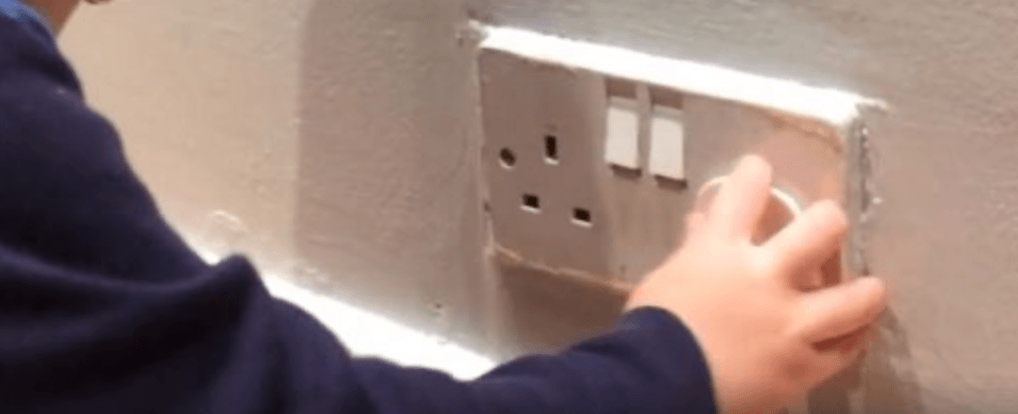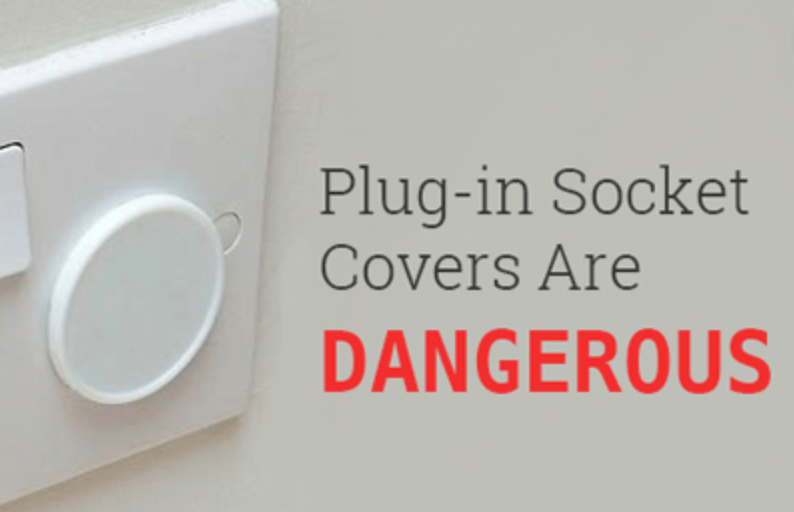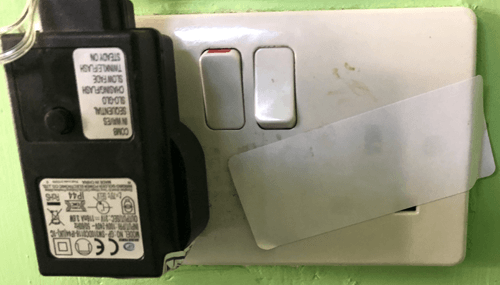These plastic ‘socket protectors‘ or ‘socket protective covers‘ are not made to any British Standard and the pin dimensions tend not to comply with BS1363, which often results in internal damage to the socket outlet contacts or their own pins braking off and getting stuck in the socket. For this reason they are not recommend. But also for this reason, the PAT engineer needs to check every socket in your property to make sure they are not damaged, including that no pins are stuck in.
How many sockets in your school, nursery or home have those little flat white ‘covers’ stuck in them? Parents and teachers plug them in to electric sockets because they think they’ll make the socket safer to children.
However, in reality – they’re actually really dangerous, pose a fire risk and increase the chances of a user getting an electric shock!
When was the last time you tried to pull one out? They’re actually really hard to get out, not only that you find yourself reaching for something thin like a screwdriver or knife to force them out, risking contact with now live parts (thanks to the ‘pins’ on the cover).
Let me explain how that happens – UK electric sockets are considered to be the safest in the world. They have a safety orientated shutter mechanism inside the socket, prevents your fingers from reaching any live wires; they’re designed this way on purpose. In fact that shutter mechanism prevents anything except a plug from reaching anything live…. anything except a plug; and that ‘safety’ socket cover you use pretends to be a plug.
There are many risks to using these socket covers, a website has even been dedicated to raising awareness of their dangers; fatally flawed lists some of the biggest risks as:
- Socket contact damage – caused by inserting the socket cover can lead to overheating and possible fires
- Socket shutter damage – caused by inserting the socket cover means the shutters will not be able to protect children or anything else inserted in a hole
- The design of some socket covers make it possible to poke pins and paper clips through them, into the live parts!
- If the socket covers’ earth pin breaks off it gets stuck in the earth hole which prevents the shutters from closing
- The pins are not always the correct size for the socket making the covers easy to remove; some even simply fall out themselves
- Some of the cover pins are the wrong size, the other way, making it nearly impossible to get them out (we added this one)
- Children like to play with the covers; plugging them in upside down opens the shutter and exposes live contacts
Socket Covers should NOT be inserted into sockets – they are dangerous!
There is loads of evidence that badly designed socket covers are a fire risk and expose live power, increasing the risk of electric shock. We have been advising clients for years against using these devices. If you really are desperate to cover a socket get a proper socket cover fitted; these can have button release or actual locks with keys. Whilst they’re not recommended for use everywhere they may just give that extra peace of mind you’re looking for.
The message here is that these covers prevent built in safety mechanisms in your sockets from working correctly; so instead of protecting your children you are in fact exposing them to an increased risk of electric shock.
Please do NOT use Electrical Socket Covers! They are not safe!
If you are using them, please, safely, remove them.
This video produced by JPS Electrical Services from Bristol highlights the dangers of using electrical socket covers.
A British safety standard from 1947 that requires the top hole of the 3-hole socket to have a “shutter” on the inside means that the live and neutral holes can’t be accessed until the shutters are opened. That happens when the earth pin of the plug is inserted into the top hole, thus opening the shutter.
Only by inserting a plug, with a top pin, can the shutter be opened, which in turn activates the live part of the socket… making the socket safe – so there is no need to cover it; even little children’s fingers won’t open the socket.
So there is no need to use “child safety covers” which have actually been found to be dangerous, or address labels!
When we are doing your PAT testing, if we come across any covers we will remove them.
PAT Testing helps to improve electrical safety
Portable appliance testing isn’t just about testing equipment to see if it is safe, but also looking at other areas of your electrical system to make sure what you are doing is safe. Perhaps cables cause a trip hazard or are so messy there is a risk of overheating. But also if we come across socket covers inserted in sockets, we’ll advise you of the dangers of continuing to use them. We also recommend if you are really concerned about sockets being accessible consider putting a closable lid socket cover over the full socket face plate.
If you require some safety guidance or your electrical equipment testing contact us by calling 0191 6661009 or emailing info@draelectricals.co.uk
You may be interested in our pages on PAT testing in schools or PAT testing in offices.




